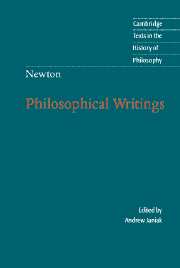Book contents
- Frontmatter
- Contents
- Acknowledgments
- Introduction
- Chronology
- Further reading
- Note on texts and translations
- I Correspondence with Robert Boyle [1679]
- II De Gravitatione [probably before 1685]
- III The Principia [1687, first edition]
- IV Correspondence with Richard Bentley [1692–3]
- V Correspondence with Leibniz [1693 and 1712]
- VI Correspondence with Roger Cotes [1713]
- VII An Account of the Book Entitled Commercium Epistolicum [1715]
- VIII Queries to the Opticks [1721]
- Index
- CAMBRIDGE TEXTS IN THE HISTORY OF PHILOSOPHY
III - The Principia [1687, first edition]
Published online by Cambridge University Press: 05 June 2012
- Frontmatter
- Contents
- Acknowledgments
- Introduction
- Chronology
- Further reading
- Note on texts and translations
- I Correspondence with Robert Boyle [1679]
- II De Gravitatione [probably before 1685]
- III The Principia [1687, first edition]
- IV Correspondence with Richard Bentley [1692–3]
- V Correspondence with Leibniz [1693 and 1712]
- VI Correspondence with Roger Cotes [1713]
- VII An Account of the Book Entitled Commercium Epistolicum [1715]
- VIII Queries to the Opticks [1721]
- Index
- CAMBRIDGE TEXTS IN THE HISTORY OF PHILOSOPHY
Summary
Author's Preface to the Reader, First Edition
Since the ancients (according to Pappus) considered mechanics to be of the greatest importance in the investigation of nature and science and since the moderns – rejecting substantial forms and occult qualities – have undertaken to reduce the phenomena of nature to mathematical laws, it has seemed best in this treatise to concentrate on mathematics as it relates to natural philosophy. The ancients divided mechanics into two parts: the rational, which proceeds rigorously through demonstrations, and the practical. Practical mechanics is the subject that comprises all the manual arts, from which the subject of mechanics as a whole has adopted its name. But since those who practice an art do not generally work with a high degree of exactness, the whole subject of mechanics is distinguished from geometry by the attribution of exactness to geometry and of anything less than exactness to mechanics. Yet the errors do not come from the art but from those who practice the art. Anyone who works with less exactness is a more imperfect mechanic, and if anyone could work with the greatest exactness, he would be the most perfect mechanic of all. For the description of straight lines and circles, which is the foundation of geometry, appertains to mechanics. Geometry does not teach how to describe these straight lines and circles, but postulates such a description.
- Type
- Chapter
- Information
- Isaac Newton: Philosophical Writings , pp. 40 - 93Publisher: Cambridge University PressPrint publication year: 2004

